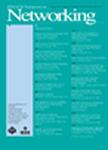版权所有:内蒙古大学图书馆 技术提供:维普资讯• 智图
内蒙古自治区呼和浩特市赛罕区大学西街235号 邮编: 010021

作者机构:Univ Sci & Technol Sch Comp Sci & Technol Hefei 230027 Anhui Peoples R China Univ Sci & Technol China Suzhou Inst Adv Res Suzhou 215123 Jiangsu Peoples R China Futurewei Technol Inc Bellevue WA 98004 USA
出 版 物:《IEEE-ACM TRANSACTIONS ON NETWORKING》 (IEEE ACM Trans Networking)
年 卷 期:2023年第31卷第1期
页 面:248-263页
核心收录:
学科分类:0810[工学-信息与通信工程] 0808[工学-电气工程] 08[工学] 0812[工学-计算机科学与技术(可授工学、理学学位)]
基 金:National Science Foundation of China (NSFC) [62102392, 62132019, 61936015] National Science Foundation of Jiangsu Province [BK20210121, 10.1109/INFOCOM48880.2022.9796938]
主 题:Cloud computing Servers Computational modeling Redundancy Network topology Approximation algorithms Protocols Southbound message delivery message queue virtual network topology virtual private cloud
摘 要:Southbound message delivery from the control plane to the data plane is one of the essential issues in multi-tenant clouds. A natural method of southbound message delivery is that the control plane directly communicates with compute nodes in the data plane. However, due to the large number of compute nodes, this method may result in massive control overhead. The Message Queue (MQ) model can solve this challenge by aggregating and distributing messages to queues. Existing MQ-based solutions often perform message aggregation based on the physical network topology, which do not align with the fundamental requirements of southbound message delivery, leading to high message redundancy on compute nodes. To address this issue, we design and implement VITA, the first-of-its-kind work on virtual network topology-aware southbound message delivery. However, it is intractable to optimally deliver southbound messages according to the virtual attributes of messages. Thus, we design two algorithms, submodular-based approximation algorithm and simulated annealing-based algorithm, to solve different scenarios of the problem. Both experiment and simulation results show that VITA can reduce the total traffic amount of redundant messages by 45%-75% and reduce the control overhead by 33%-80% compared with state-of-the-art solutions.